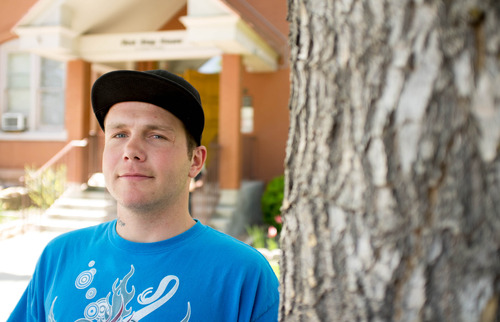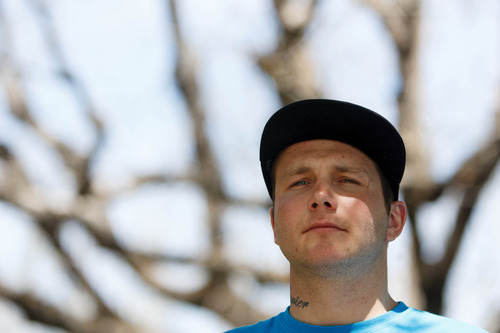This is an archived article that was published on sltrib.com in 2013, and information in the article may be outdated. It is provided only for personal research purposes and may not be reprinted.
Alcohol left Derrick Lunt's life in a shambles — he was jobless and, for nearly five years, living on the streets or sometimes crashing in a shelter or on a friend's couch.
"I'm always in trouble. I'm tired of being homeless and not having a stable job, and I have a little boy, and my relationship with him has been really, really messed up," said Lunt. "I just decided it was enough."
Now Lunt, 26, is getting help through the First Step residential-treatment program and is eager to get his life back on track.
But Lunt had to wait four months to get into the program — a function of the demand for the services — which he said discouraged him from getting help for months. And the wait is expected to get longer as the program feels the impacts of federal budget cuts, the result of the sequestration now taking effect.
The four- to five-month wait could climb to six months or longer as the program loses its funding, said Raye Silvers, admissions coordinator for the program.
Many, especially those awaiting treatment while serving time in jail, will never receive the treatment they need and instead be put back out on the street, where they could end up in emergency rooms, psychiatric wards or back behind bars.
"The sooner you can get people help who are struggling, who are really willing to try to change their life, that would be great for everyone," Lunt said. "The people who are struggling out there, who can't get a job, they end up doing stupid things to survive."
As many as 152 people in Salt Lake County alone may not be able to receive the substance-abuse treatment they need, or may find themselves on waiting lists for services as a result of diminishing federal dollars, said Pat Fleming, director of the county substance-abuse and mental-health treatment program.
Nineteen may not be able to get access to mental-health treatment, Fleming said.
The sequestration cuts put additional strain on a system that is stretched to the point that there is already a waiting list for services.
"If we don't [get them into treatment], they'll wind up in emergency rooms, in county jails or out on the streets," said Fleming. "This disease kills people. I read the obituaries every day and you can see it. You can see the people who have died, especially these young folks."
—
Real lives • The cuts to mental health are just one example of dozens of programs being trimmed as a result of the federal sequestration — the impacts of which are still filtering down from abstract budget concepts in Washington to the lives of people around Utah and the rest of the country.
All told, the state anticipates seeing about $47.5 million in reduced federal spending. It is a small portion of the more than $4.7 billion in federal money that goes into the state budget, but there will be ramifications.
Utah lawmakers decided during the past legislative session not to try to fill in any of the holes left by the sequestration cuts, and state law prohibits agencies from shifting money around to try to cover the shortfall themselves.
"Dealing with these cuts will be challenging, I don't want to downplay that, but it should be manageable," said Juliette Tennert, budget director for Gov. Gary Herbert.
The cuts will hit low-income housing programs, food assistance, college work-study programs, aid to refugees and emergency-preparedness outreach, among scores of other cuts.
Utah's crime victims-assistance program, for example, receives money through several federal grants to provide legal, medical, counseling and other crisis services to victims of rape, domestic violence and child abuse and families of homicide victims.
Last year, there were about 360,000 services provided to 63,552 crime victims — although some victims are counted twice if they receive different types of services through domestic-violence shelters, rape-recovery centers, legal aid or other providers.
This year, the state is telling providers to plan on a 10 percent cut in federal funding for the budget year starting July 1 and is anticipating another 7.2 percent reduction next year.
That means victims of certain crimes may not be eligible for assistance or the types or quality of help available may have to be scaled back, said Christine Watters, assistance coordinator for the Utah Office for Victims of Crime.
"You're talking about people who are unaware of the system, but are in a crisis because they've been a crime victim and then are immediately immersed in a system they don't understand," she said. "You're talking about rape victims who immediately need to go to a hospital and receive treatment and crisis intervention. … You're talking about child physical abuse and little children with parents who are sexually abusive."
—
School impacts • Utah schools, for example, will take one of the biggest hits. Low-income schools are expected to lose $3.2 million in Title I funding, and districts will have to cope with a $5.6 million reduction to special-ed programs.
With the Title I funding, the impacts likely can be absorbed, since they will be spread across numerous schools. School districts and charter schools, which are now putting together their budgets for the next school year, will simply need to plan for the reduced funds.
When it comes to special-ed funding, the state has to maintain the same level of services for students in the program, said Bruce Williams, the Utah Department of Education's budget director. That likely means having to shift dollars from other programs to make up for the reduced federal funding.
"They're just going to have to adjust," said Williams. "It's sad to say, but it's just what they're going to have to do from the Utah State Office of Education's perspective."
But it is not a major hit, Williams said, considering federal funding makes up 7 percent of the public school budget, and a 5 percent reduction to that means just a 0.35 percent overall education reduction.
—
Mining money • Resource-producing counties will face the loss of $2.8 million in mineral-lease payments, which are distributed to communities affected by oil and gas drilling to help build roads, buildings, parks, water systems and to meet demands created by the industries.
"That's real money. It does make a difference," said Mike McKee, a Uintah County commissioner and member of the Community Impact Board, which allocates the mineral-lease funds.
McKee said the mineral-lease funds were used to build a new senior center and library in his community.
"A lot of good, worthwhile projects have been built," he said. "It's concerning to us to see those cuts. We certainly hope they're not permanent, and we hope we at least minimize the damage that is done."
Utah's Division of Emergency Management will lose about $378,000 in emergency management and homeland-security grants, but those cuts will be spread among numerous agencies, so the impacts should not be major, said Joe Dougherty, spokesman for the division.
It could mean the division won't put on as many emergency-preparedness fairs or could scale back other outreach programs, but layoffs are not anticipated.
Twitter: @RobertGehrke







